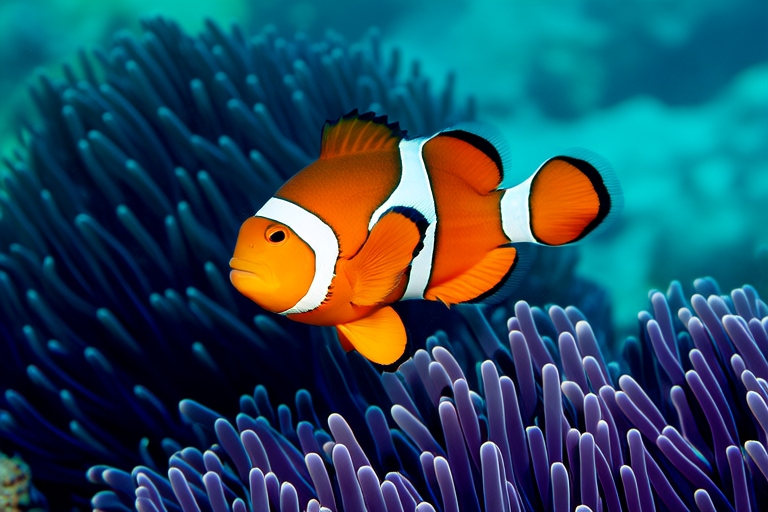The Journey of Clownfish: From Fiction to Reality
Clownfish, popularized by Disney Pixar’s animated film Finding Nemo , have captivated audiences worldwide with their vibrant colors and amusing antics. However, beyond the realm of animation, these fish play crucial roles in marine ecosystems and face numerous challenges that threaten their survival. This article delves into the fascinating world of clownfish, exploring their symbiotic relationship with sea anemones, habitat preferences, breeding behaviors, and面临的生存挑战,including climate change and habitat destruction. We will also analyze how these factors impact their survival and discuss the importance of conservation measures and public education.
Symbiotic Relationship with Sea Anemones
Clownfish possess a unique and mutually beneficial relationship with sea anemones, which serves as their primary habitat. The anemone’s tentacles, equipped with stinging cells called nematocysts, provide protection against predators. In return, clownfish offer nutrients through their waste products and attract prey for the anemone. This symbiosis is made possible by a special layer of mucus on the clownfish’s skin that prevents the anemone from detecting them as potential food. Without this protective layer, the clownfish would be vulnerable to the anemone’s sting. The clownfish’s vibrant coloration, often featuring orange, white, and black stripes, may serve as a warning to potential predators, indicating their poisonous nature due to the anemone’s venom.
Habitat Preferences
Clownfish inhabit coral reefs across the Indo-Pacific region, including the Great Barrier Reef, the Red Sea, and the Coral Triangle. They prefer shallow waters near the shore, typically between depths of 1 to 15 meters. Coral reefs provide essential habitats for clownfish, offering shelter, food sources, and breeding grounds. However, coral reefs are highly sensitive to environmental changes, making clownfish particularly vulnerable to disturbances such as pollution, overfishing, and climate change. The loss of coral reefs can lead to a decline in clownfish populations, as they rely on these structures for survival.
Breeding Behaviors
Clownfish exhibit complex social structures within their anemone homes, where only one pair of fish becomes reproductive. The dominant female and male are responsible for producing offspring, while the other clownfish in the group remain non-reproductive. When the dominant female dies, the dominant male undergoes a remarkable transformation, changing sex to become the new dominant female. This process, known as sequential hermaphroditism, ensures the continuation of the species. Clownfish spawn during specific lunar cycles, with the female laying thousands of eggs on the anemone’s base or nearby rocks. The male then guards the eggs until they hatch, ensuring their safety from predators. After hatching, the larvae drift in the open ocean before settling on suitable coral reef habitats.
面临的生存挑战
Climate change poses significant threats to clownfish and their habitats. Rising sea temperatures cause coral bleaching, a phenomenon where corals expel the algae living in their tissues, leading to their death. As coral reefs degrade, clownfish lose their primary habitats and sources of food. Additionally, increased ocean acidity resulting from higher carbon dioxide levels can affect clownfish behavior and development. Studies have shown that elevated CO2 levels can impair clownfish larvae’s ability to detect predators, making them more susceptible to predation. Habitat destruction, primarily caused by human activities such as coastal development, pollution, and overfishing, further exacerbates clownfish’s challenges. These factors collectively contribute to declining clownfish populations and disrupt the delicate balance of marine ecosystems.
Impact of Challenges on Survival
The面临的生存挑战 faced by clownfish have profound implications for their survival and the health of marine ecosystems. The loss of coral reefs not only affects clownfish but also impacts countless other species that depend on these ecosystems. As clownfish populations decline, the entire food web may be disrupted, leading to cascading effects throughout the ecosystem. Furthermore, the decline of clownfish could have economic consequences for regions that rely on tourism and fishing industries. Protecting clownfish and their habitats is crucial for maintaining biodiversity and ensuring the sustainability of marine resources.
Protection Measures and Public Education
To address the面临的生存挑战faced by clownfish, various protection measures have been implemented. Marine protected areas (MPAs) have been established to safeguard critical habitats and allow ecosystems to recover. MPAs restrict human activities such as fishing and development, providing clownfish and other marine species with safe havens. Additionally, efforts to reduce greenhouse gas emissions and combat climate change are essential for mitigating the impacts of rising sea temperatures and ocean acidification. Public education plays a vital role in raising awareness about the面临的生存挑战and promoting sustainable practices. By educating people about the importance of clownfish and their habitats, we can foster a sense of responsibility and encourage individuals to take action. Initiatives such as beach cleanups, coral reef restoration projects, and responsible diving practices can help protect clownfish and their environments. Engaging communities and fostering a culture of conservation are key to ensuring the long-term survival of clownfish and the preservation of marine biodiversity.
Conclusion
The journey of clownfish from the fictional world of Finding Nemo to their reality in the ocean highlights their significance in marine ecosystems and the面临的生存挑战they face. Their symbiotic relationship with sea anemones, habitat preferences, and breeding behaviors make them fascinating subjects of study. However, climate change and habitat destruction pose significant threats to their survival, affecting not only clownfish but also the broader marine environment. By implementing protection measures and promoting public education, we can work towards safeguarding clownfish and preserving the beauty and diversity of our oceans for future generations. It is our responsibility to protect these remarkable creatures and the ecosystems they inhabit, ensuring a thriving and sustainable marine world.
